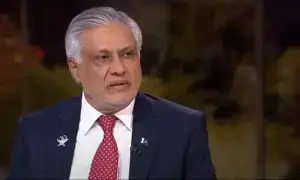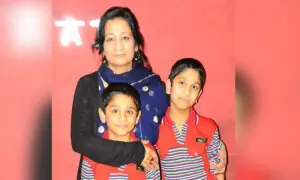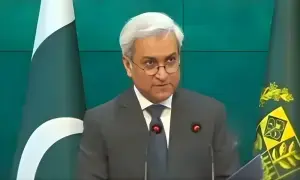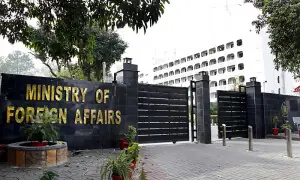After-effects of 'economic stabilisation'
 Photo: FILE
Photo: FILEIn his budget speech, the Federal Finance Minister's sole explanation (offered repeatedly) for not meeting any of the budgetary targets set for FY16 was the fact that Pakistan was nearing bankruptcy when the PML-N took over its administration in May 2013, and this state of the economy required prioritising 'economic stabilisation'.
Although he didn't explain why PML-N couldn't prevent the economy's slide during the last PPP government, which pushed Pakistan ever-closer to bankruptcy, we know that the reason for PML-N's ceremonial criticism of this suicidal trend was both parties' agreement, courtesy the 'Charter of Democracy', on letting each party rule Pakistan for a full five-year term.
He also didn't disclose the government's efforts(under its 'economic stabilisation' plan) for expanding the tax-net to increase the share of direct taxes in the tax revenue, though he kept claiming that in the last three years of PML-N's rule, tax revenue had increased by 59 percent, without referring to almost suicidal reliance on imposing and collecting indirect taxes.
The fact that the report submitted by the Tax Reforms Commission (set-up in 2014) wasn't made public, and admission of the commission's chairman before the Senate that reforms proposed by the commission haven't been implemented and the number of tax return filers had declined by 18 percent, explains the Finance Minister's silence on this critical issue.
Obviously, the Finance Minister isn't bothered by the fact that indirect taxes (impacting the rich and poor alike thus defying the ability-to-pay principle) are the route to increasing poverty; that indirect taxes now account for almost two-thirds of the total tax revenue is the proof thereof, and how much they added to poverty is also not a secret.
While the government claims that unemployment rate is 5.9 percent, literacy level has reached 60.7 percent, just 23.3 percent of the population is below the poverty line, and per capita income is now $1,435 independent research institutions dispute these figures. In fact, some institutions estimate that nearly 53 percent of the population has now fallen below the poverty line.
The key factor rendering these estimates doubtful is that since 1998, no population census was conducted. These statistics are therefore not as close to reality as they ought to be, for assessing the real rate of socio-economic uplift. Neither the PPP nor the PML-N regime realised that, given this flaw, all their claims of economic growth will lack credibility.
These estimates, provided by the Pakistan Bureau of Statistics and the Economic Survey, have lost their credibility because they report a brighter than actual picture of the economy. What no government seems to realise is that dearth of reliable socio-economic statistics is a major factor hindering investment, especially foreign investment.
Above all, it is worth asking whether the 18th constitutional amendment that devolved federal administrative powers to the provinces served any purpose. Isn't it true that after this change the state of basic education and health services deteriorated rapidly, and now blocking the local government system is resulting in deterioration of even the basic civic services?
This scenario is forcing people to 'buy' every basic service that they expect the state to provide in return for the taxes they pay, which is inducing tax-evasion. It is self-deluding to keep blaming the Federal Bureau of Revenue (FBR) for not collecting higher taxes. Given its own miserable performance on these counts how can the state expect FBR to collect more direct tax?
In the context of 'economic stabilisation', it is worth asking whether a 3-year long slide in exports, courtesy power load-shedding and not paying back refundable taxes, and the mega decline in output of the agricultural sector, courtesy higher indirect taxes and import of sub-standard seeds and fertiliser should have been the outcome of this strategy.
While offering tax relieves to five export-oriented sectors is commendable, will the exporters who lost their foot-hold in today's overly competitive foreign markets, be able to regain that foot-hold quickly enough to fulfil the government's expectation about exports rising from $19bn in FY16 to $24.5bn in FY17? Besides, can power load-shedding be cut down drastically in FY17?
Regaining access to lost foreign markets isn't easy; it requires cutting prices drastically and extending longer term credit to the buyers. This is the cost of the 3-year long 'economic stabilisation' policy that exporters must pay. How much will the new 'no tax, no refund' policy and the minor cut in mark-up rate on export re-finance boost exports, remains to be seen.
Why didn't the 'economic stabilisation' strategy postpone the over-priced Metro Bus and Orange Railway projects to save resources for timely payment of refundable taxes to the export sector, revamping the power transmission and distribution systems to cut line losses and load-shedding, and lowering of fuel prices to slow the sliding competitiveness of the economy?
The Finance Minister's promise to pay all tax refunds claims (estimated to be around Rs 250bn) by August 31, appears attractive. But, given the fact in FY16 just Rs 1.4bn of these taxes were repaid, could this happen since despite its huge borrowing, the government is short of liquidity, as manifested routinely by the street protests of even the low-paid state employees.
This promise foretells further addition to the public debt. Since 2013, domestic public debt has risen by Rs 4.55 trillion to 18.85 trillion and external debt from $60.9 billion to $68.5 billion, making default on its timely servicing a possibility because repayment of the rescheduled external debt will commence in FY17. On top thereof, fiscal deficit in FY17 is projected to be Rs 1,276 billion.
Promises to the agriculture sector about cutting the cost of fertilisers and pesticides and lowering the power tariff are commendable. But those who allowed import of sub-standard seeds and fertiliser in FY16 must be identified and held accountable, and research-based yardsticks specified to ensure that these interests don't participate in the import process.
Allocation for PSDP has been increased by 14.5 percent over its FY16 level, but because only 68 percent of the FY16 allocation was disbursed doesn't build hopes of full utilisation of the FY17 allocation. Is there a guarantee that this allocation won't be slashed to cut the fiscal deficit? Besides, 96.1 percent of the FY17 allocation is for existing projects; only 3.9 percent is for new projects.
The much needed increases in federal government employees' salaries contradict the claim about lower inflation - the claim used to justify lowering of the mark-up rate on government borrowing from the banking sector that also reduced the profit rates on savings. This 3-year trend of lowering the mark-up rate foretells that targets set for higher savings, and thus investment, won't crystallise.
For the vast majority of Pakistanis, not lowering or withdrawing indirect taxes implies zero relief. Poverty is rising despite government's denial thereof, and fuelling frustration among the vast low-paid majority - the outcome to-date of the 'economic stabilisation' that slowed economic growth. Sadly, the present budget doesn't promise a reversal of this dangerous trend.















Comments are closed on this story.